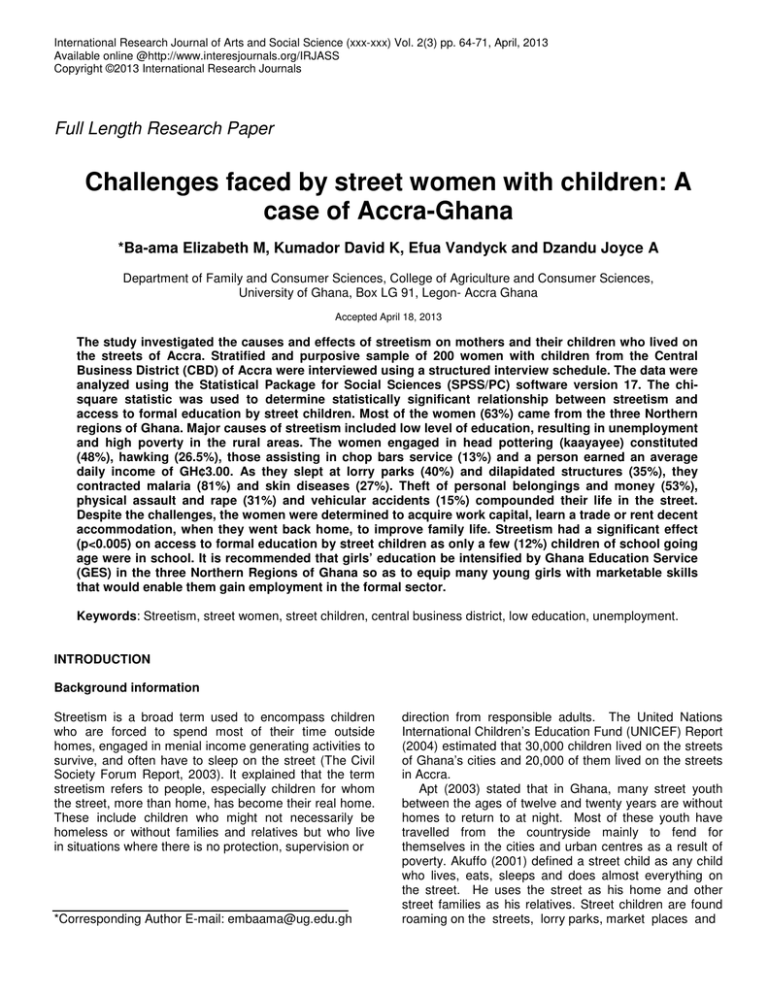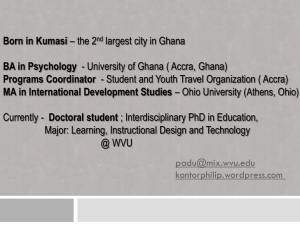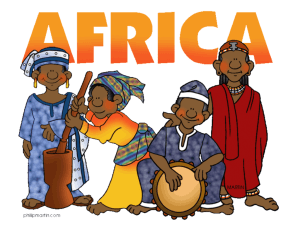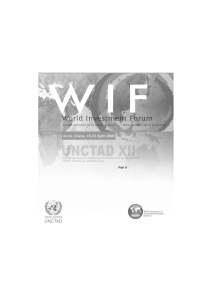Document 14092718
advertisement

International Research Journal of Arts and Social Science (xxx-xxx) Vol. 2(3) pp. 64-71, April, 2013 Available online @http://www.interesjournals.org/IRJASS Copyright ©2013 International Research Journals Full Length Research Paper Challenges faced by street women with children: A case of Accra-Ghana *Ba-ama Elizabeth M, Kumador David K, Efua Vandyck and Dzandu Joyce A Department of Family and Consumer Sciences, College of Agriculture and Consumer Sciences, University of Ghana, Box LG 91, Legon- Accra Ghana Accepted April 18, 2013 The study investigated the causes and effects of streetism on mothers and their children who lived on the streets of Accra. Stratified and purposive sample of 200 women with children from the Central Business District (CBD) of Accra were interviewed using a structured interview schedule. The data were analyzed using the Statistical Package for Social Sciences (SPSS/PC) software version 17. The chisquare statistic was used to determine statistically significant relationship between streetism and access to formal education by street children. Most of the women (63%) came from the three Northern regions of Ghana. Major causes of streetism included low level of education, resulting in unemployment and high poverty in the rural areas. The women engaged in head pottering (kaayayee) constituted (48%), hawking (26.5%), those assisting in chop bars service (13%) and a person earned an average daily income of GH¢3.00. As they slept at lorry parks (40%) and dilapidated structures (35%), they contracted malaria (81%) and skin diseases (27%). Theft of personal belongings and money (53%), physical assault and rape (31%) and vehicular accidents (15%) compounded their life in the street. Despite the challenges, the women were determined to acquire work capital, learn a trade or rent decent accommodation, when they went back home, to improve family life. Streetism had a significant effect (p<0.005) on access to formal education by street children as only a few (12%) children of school going age were in school. It is recommended that girls’ education be intensified by Ghana Education Service (GES) in the three Northern Regions of Ghana so as to equip many young girls with marketable skills that would enable them gain employment in the formal sector. Keywords: Streetism, street women, street children, central business district, low education, unemployment. INTRODUCTION Background information Streetism is a broad term used to encompass children who are forced to spend most of their time outside homes, engaged in menial income generating activities to survive, and often have to sleep on the street (The Civil Society Forum Report, 2003). It explained that the term streetism refers to people, especially children for whom the street, more than home, has become their real home. These include children who might not necessarily be homeless or without families and relatives but who live in situations where there is no protection, supervision or *Corresponding Author E-mail: embaama@ug.edu.gh direction from responsible adults. The United Nations International Children’s Education Fund (UNICEF) Report (2004) estimated that 30,000 children lived on the streets of Ghana’s cities and 20,000 of them lived on the streets in Accra. Apt (2003) stated that in Ghana, many street youth between the ages of twelve and twenty years are without homes to return to at night. Most of these youth have travelled from the countryside mainly to fend for themselves in the cities and urban centres as a result of poverty. Akuffo (2001) defined a street child as any child who lives, eats, sleeps and does almost everything on the street. He uses the street as his home and other street families as his relatives. Street children are found roaming on the streets, lorry parks, market places and Ba-ama et al. 65 future of our communities is in danger due to the phenomenon of streetism of the family. Africans have an adage that “it takes the whole community to raise children”. This is because children are both the product and basic unit of a community and society at large. When children are brought into the world, they must be trained in the acceptable modes of behaviour of the society. Nukunya (2003) asserted that it is the responsibility of parents, where they lived together, to be directly involved in the exercise of good upbringing of the children. In this case, the street is not a conducive environment for establishing families. However, the problem of families living on the street seems to be on the increase in many societies today. The Statesman Newspaper (2006) reported that, there had been a growing disregard for the street child. But society must remember that, in every street child, there is a potential cutlass wielding robber and a potential or actual drug addict. These are children that have virtually nothing to lose. They are a threat to themselves and a threat to the very society that shun them. What is of worry according to the report is the fact that streetism does not involve young girls only but many mothers who are on the street with their children. One wonders how these mothers cope with child upbringing on the street in spite of the many challenges. Women with children on the street are exposed to manner of dangers, such as malaria, rape and sexually transmitted diseases. Besides, parents do not have enough attention for their children in terms of feeding, moral and formal education, a situation which could have negative impact on these women, their children and the nation at large. The study therefore sought to investigate the challenges faced by street mothers and their children in Accra. street corners begging for alms or in a wage earning activity. They do not have homes and therefore spend their nights in kiosks, street corners, or chop bars. The Human Rights Watch report (2006) stated that adults in recent times have also been on the street and children have been produced and brought up on the street by the individuals on the street. Some families also moved into the street as a result of broken homes or divorce. Many young girls, who did not have any trade or vocation, came to the city to secure jobs; these girls were impregnated by unemployed men and since t hey had nowhere to go, they stayed on the street with their children. Other factors include neighbourhood and family dysfunctions that increased the vulnerability of families particularly children and women to go onto the streets. Eyiah (2003) reported that some single mothers had also encouraged their teenage daughters to go onto the street to make ends meet. They ended up in prostitution, were sometimes raped and eventually had become homeless mothers on the street. A study by ObengNyarko (1998) on street children at Agbogbloshie market revealed that some children were on the street not necessarily because they did not have homes but they lived in situations where there was no protection, supervision or direction from responsible parents/adults. Some children accompanied their parents to work in the cities and urban centres where they assisted in the sale of wares and they made market sheds and the street their homes. The children helped in operating chop-bars, carried loads in the market places or construction sites in urban centres and made these sites their homes. Mclaughlin (1987) also attributed streetism to the low income of the average Ghanaian family which made younger family members go onto the street to sell to supplement the efforts of their parents to meet their economic needs. Apt (2003) reported that some teenage girls were ‘driven’ away from their homes by their parents when they became pregnant. As a result, these teenagers got onto the street and raised their families. Issues relating to the numbers of families on the street, market places, lorry parks and video centres call for much concern on the part of government and all who care about the welfare and the development of the family. Streetism is associated with untold hardship of the street environment which usually affects the systematic development of the children of the street women. The Human Rights Watch Report (2006) noted that street children throughout the world were subjected to physical abuse by police or had been murdered outright, as governments treat them as a blight to be eradicated rather than as children to be nurtured and protected. Women and girls were also victims of rape, domestic violence, sexual exploitation, trafficking, sexual humiliation and mutilation. Eyiah (2003) warned that, the Objectives of the study The aim of the study was to investigate the causes and effects of streetism on women and their children who lived on the streets of the Central Business Districts of Accra. The specific objectives were to:1. Investigate factors that made women with children live on the street. 2. Identify challenges faced by the women and their children on the street. 3. Ascertain the coping strategies adopted by the women. It was hypothesized that there is no relationship between streetism and access to formal education by street children. The study would highlight some major causes of streetism in Ghana especially in the urban cities. This would help stakeholders and policy makers take effective steps to reduce the number of women with children on the street. 2 66 Int. Res. J. Arts Soc. Sci. METHODOLOGY Statistical Package for Social Science (SPSS) Computer Software version 16.0. The chi-square statistic was used to test the Null hypothesis. Data presentation is mainly descriptive using tables and graphs where appropriate. Study Area The study area was the Central Business District (CBD) of Accra. This area includes Tudu/ Novotel, Okaishie/Mokola, Tema station and Agbogbloshie/ Kantamanto. This area was chosen because it is the busiest business centre where the phenomenon of street women with children is most prevalent. Moreover, Accra is the largest city in Ghana, hence, a place where major economic activities take place. RESULTS AND DISCUSSIONS Demographic characteristics of the street women Region of origin The women were mainly Ghanaians (91%) with a few non-Ghanaians made up of Togolese (5%), Nigerians (3.5%) and Burkinabes (0.5%). Among the Ghanaians, (62.5%) hailed from the three Northern regions of the country (namely Upper East, Upper West and Northern regions). The high percentage of street women coming from the northern part of the country could be attributed to the poor living conditions caused by the low level of education resulting in lack of employable skills just as stated by Akuffo (2001) that their migration to the southern part of the country was due to the high drop-out rates in women’s education in the northern part of Ghana. The findings also confirm that of UNICEF Report (1995) that most of the street women came from the northern part of Ghana. Population, Sample size and Sampling procedure The study population was all street women (15 years and above) with children, who had lived on the street of Accra for at least three months. Stratified and purposive sample of 200 street women were selected. The study area was first clustered into four (4) groups, namely, Tudu/Novotel, Okaishie/Makola, Tema Station and Agbogbloshie/ Kantamanto markets. In each cluster, fifty (50) street women with children were purposively selected. Initial verbal questions were asked to ensure that the women met the criteria for inclusion in the study. Data Collection The data were collected using a structured interview schedule with both open and closed ended questions. The instrument was designed to elicit responses on:• Background characteristics of the women. • Factors that made women with children live on the street. • Challenges faced by street women with children. • Coping strategies adopted by street women with children. The interview schedule was pre-tested using ten (10) street women with children at the Madina market who had similar characteristics. The pre-test enabled the researchers determine the clarity and reliability of the interview schedule. The face-to-face interviews were conducted in Twi, Hausa, Dagbani, Ga and Ewe, since many of the women could not understand or speak English language. Three research assistants were trained to help collect the data. The questions were interpreted into the local languages and the responses recorded in English. The interviews were conducted largely on Sundays when the women were less busy and were at their resting places. Age distribution of the street women The majority (93%) of the street women aged below 40 years as presented in Table 1 below. It is obvious from the results that the women with children living on the street were in the economic active age group just as indicated by Azumah (2006) that those who were found on the street were energetic youth who were supposed to be engaged in more difficult jobs like farming. Marital Status More than half (55%) of the street women were married. The rest were:- single (25%), separated (8.0%), widowed (6.0%), and divorced (5.0%). Contrary to the belief that the upsurge of streetism among women with children may be due to the pressures of separation of partners and single parenting, the study revealed that more than half of the women (55%) were still in conjugal relationships. It could be deduced that the husbands of these women could not provide for the needs of the family hence, the women’s decision to travel down to Accra to work and look after themselves and their children. These women were engaged in both polyga- Data Analysis The data were hand coded and analyzed using the 3 Ba-ama et al. 67 Table 1. Age distribution of the street women Age Range (yrs) No. % ≤19 20 – 29 30 – 39 40 – 49 50 – 59 TOTAL 63 94 29 12 2 200 31.5 47.0 14.5 6.0 1.0 100 mous (58%) and monogamous (42%) marriages. Those in polygamous relationships had co-wives ranging between one and three. Both types of marriages were contracted under Islamic or traditional marriage arrangements. Educational level of the women Nearly two-thirds of the women (64%) had no formal education, 22% were school drop outs while only 14% had formal education. Those who had formal education were made up of basic/Islamic education (7%), secondary education (5%) and vocational/commercial (2%). The low educational level of women confirms findings by Symes (2007) that at the national level, there is a decline of girl child enrolment from the basic level to the SHS at the public schools. As regards their religious affiliation, 61% were muslims, 36% were christians and 3% traditionalists. Many of the women were muslims probably because the majority of them hailed from the muslim communities in the northern part of Ghana. Number of children of the women The women had between one and five children, with an average of two children. Forty-three percent of the women had only one child, 31% had two children, and 26% had five children. However, the number of children living with their mothers on the street varied between one and three. Eighty-five percent had only one child living with them on the street, 12% had two children and 3% had up to three children. This implies that some of the children could be living with other people back home. The ages of the children living with their mothers on the street ranged between 6 months and 10 years. Sixty-four percent of the street women had children between one and four years, 26% had children below one year and only about 10% had children aged ten years. Many of the children living with their mothers on the street were four years and below, a stage at which they were considered too young to be separated from their mothers, or too dangerous to be entrusted in the care of other people. How the street women came to Accra About 56% of the street women came to Accra by themselves, 32.5% were brought by relatives, while 11.5% were brought by non-relatives and agents who charged them a fee or took a certain percentage of the income they earned. These agents usually had customers, mainly food vendors in the city to whom they brought these women. This finding confirms that of Apt (2003) that some of the women on the street were brought from their villages to Accra by agents who charged them. The majority of the women (89.5%) indicated that they were on the street to work for money, so they could cater for themselves and their children’s basic needs. This revelation is in conformity with Asare’s (1995) findings that it could be purely due to economic motives that drew people from rural areas to urban centres. Economic activities engaged in by the street women Nearly half (48%) of the street women worked as head potters (carrying load), 27% sold items, 13% worked in chop bars, while 4.5% were shop assistants. This finding confirms the Statesman Newspaper Report (2006) that most of the street dwellers that inhabited Accra did what they could do to get money by doing all manner of jobs which sometimes affected their human dignity. (Figure 1) The average income earned by the women on a busy day was GH¢4.86 and GH¢2.47on a non busy day. It is however worth mentioning that on some bad days the women did not earn any income at all. Challenges faced by the street women Access to shelter Forty-percent of the street women lived at lorry parks in the city, 35% lived in kiosks and 17% slept in front of shops around the area in which they operated. A few (7.5%) found shelter in chop bars, fuel filling stations and stores in which they worked. Those who lived in kiosks 68 Int. Res. J. Arts Soc. Sci. Figure 1. Kinds of work engaged in by the street women and containers experienced congestion and poor ventilation. The Statesman newspaper (2006) reported that most of the street dwellers were homeless and slept on sidewalks or abandoned building sites. Forty percent of the women paid for the places where they slept as rent, tips or a token for the security personnel or caretakers manning the lorry parks, shops and the other places. Those who lived in kiosks paid an average of GH¢ 1.00 a week as rent. Since the women lived in groups of about ten people, they contributed to pay the rent. Access to water, toilet and bath Over 96% of the women bought pipe borne water from stand pipes and other sales points within their vicinity. The payment for utilities as they used them posed problems since some of them did not have enough money to pay. Almost all the women (99.5%) used public toilets and bathrooms. A few (5%) bathed in the open place or in nearby houses. For almost all those who did not live in any well built structures, changing their clothes or dressing up was very difficult. They did so either in the public bathhouses, public toilets, in the chop bars or behind vehicles at the car parks. while 14% ate two meals. With regard to how women obtained their meals, slightly more than three quarters (77%) bought cooked food from food vendors on the street or at the chop bars, 10% cooked on their own or bought from vendors when they were unable to cook, while about 8% depended solely on their own prepared meals. The rest (5.5%) either ate at chop bars where they worked or depended on the benevolence of others for their food. Most of the women bought cooked food probably due to convenience since the environment in which they lived was not conducive for cooking their own meals. The most common food for breakfast consumed by 67% of the women was koko with bread, koose, groundnut or puff loaves. The rest (33%) however ate heavy meals such as banku, fufu, kenkey, plantain and tuo-zaafi. Lunch meals included rice with gravy /stew or waakye (47%), banku or tuo-zaafi with ayoyo or okro soup (38%). The rest (15%) ate kenkey with hot pepper and fried fish. Supper meals were similar to lunch. In spite of the fact that they ate some protein foods such as meat or fish, the quantities were inadequate since they could only afford small pieces or bought food without fish or meat. It was also possible that they did not have enough money to spend on protein foods since they wanted to save money. Health problems faced by the women Feeding Eighty six percent of the women ate three times a day Ninety-one percent of the women reported frequent illhealth conditions, 40% fell sick weekly, 30% experienced Ba-ama et al. 69 Table 2. Daily expenditure (GH¢) of the street women Items No. Food Utilities, water, bathing, etc. School fees Keeping a baby with someone 200 200 21 8 sickness fortnightly while 21% fell sick once a month. A major cause of sickness was malaria (81%). Other common health problems were skin diseases (27%), abdominal pains (12%), diarrhoea (9.5%) and dental on problems (4.5%). The high prevalence of malaria could be attributed to the sordid environment in which they lived since that formed good breeding grounds for mosquitoes. In addition, the filth, congestion in their dwelling places and poor ventilation could also enhance the rapid spread of diseases just as stated by Gyampson (2006) that when the environment is polluted and degraded it does not make it safe for human habitation. As regards access to medical care, 75% of the women did not access health care at accredited health facilities where they could be attended to by qualified medical practitioners. More than half of the women (57%) practiced self-medication, 25% sought treatment at health facilities such as Clinics, Hospitals and Health centres, while 18.5% resorted to herbal treatment. The percentage of self medication (57%) is higher than figures quoted by the Ghana Statistical Service Report (2006) on Ghana Living Standards Survey that among the poorest 20% of the urban population, 38% purchased drugs from pharmacies/chemical stores. Some reasons for not accessing medical care at approved health centres included high medical fees (72%), waste of time at the health centres (16%) and the perception that orthodox medicine was not very effective as compared to herbal ones (12%). The amount of money spent on health care per week ranged between GH¢ 2.50 and GH¢60.00 with an average of GH¢ 38.30. Threats encountered by the women More than half of the women (53%) reported theft of personal effects and money, 29% reported abuse and assault while 14.5% indicated that they were exposed to being knocked down by vehicles in the course of doing their businesses. A few, (4.5%) reported rape, fire outbreak in their dwelling places (especially in the wooden kiosks) and constant harassment from police and city guards. The high theft cases could be attributed to the large number of women living in one kiosk just as reported by Anyidoh (2006) that women on the street complained of theft of their monies and other belongings. Minimum/ GH¢ 0.3 0.1 0.1 0.2 Maximum/ GH¢ 8.0 2.5 2.0 1.0 Mean/ GH¢ 1.30 0.47 0.43 0.39 The absence of secured locks to the kiosks in which they lived could also be a contributing factor to the theft cases they experienced. With regard to security, 54% indicated that they felt insecure as a result of overcrowding and petty theft among themselves. Other reasons included the fact that there were no measures put in place such as police protection or the presence of private security personnel (23.8%) while 9.5% had experienced some form of assault or molestation on the street, hence the feeling of insecurity. Coping mechanisms adopted by the women to mitigate the challenges faced Shelter was the biggest challenge for the street women since they could not afford to rent decent rooms in the city. Hence they adopted such measures as locating others who were already on the street and hailed from their home communities and lived with them (96%). Sixtytwo percent of the women said they lived and moved in groups and avoided being isolated as a precaution against rape. Those who suffered some form of verbal abuse or assault indicated that they coped by ignoring the aggressors or aggrieved clients (11.6%) and in a few cases they fought to defend themselves. As a preventive mechanism against theft, 53% kept their valuables with others at places considered safer, 30% left their items in the care of the watchmen at the lorry stations or parks and 20% kept theirs with relatives who had good accommodation. Majority of them (76.5%) protected their money by saving with “susu collectors” for safe keeping until they needed it. Periodically the women (90%) sent all their acquired properties to their home towns as a measure against theft. Expenditure of the women Food constituted the main expenditure of women. They spent a daily average of GH¢1.30 on food, GH¢0.47 on water for bathing and washing clothes. The few who had a child or children in school paid a mean amount of GH¢8.60 monthly for school fees, and GH¢7.80 for babysitting (Table 2). 70 Int. Res. J. Arts Soc. Sci. Table 3. Cross tabulation of age of children and where they were left during working hours. Places where children were kept Sent them to school Carried them while working They worked on the street Left them with some other people Stayed with me at the work place TOTAL Age of Children >4years <4 years No. % No. % 13 6.5 12 6.0 11 5.5 125 62.5 8 4.0 3 1.5 5 2.5 16 8.0 1 0.5 6 3.0 38 19.0 162 81 Despite the low earnings, the women (95%) made some savings between GH¢8.50 - GH¢10.00 a week with an average weekly savings of GH¢8.00 with “susu collectors”. The savings were used to buy personal effects, cloth, household chattels (40%), and raised capital for their future preferred trade (30%) and for their children’s education (10%). Test of Hypothesis To test the null hypothesis that there is no relationship between streetism and access to formal education by the street children, a cross tabulation of the age of children and where they were left during working hours of their mother was done. The chi square test revealed a significant relationship (p 0.05) between streetism and inaccessibility to formal education by street children since only a few of the children (12%) aged 4 years were in school. This could be attributed to the street women’s inability to meet educational expenses. (Table 3) SUMMARY, CONCLUSIONS RECOMMENDATIONS AND The study revealed that major contributory factors to streetism among women with children in Accra included low level of education (86%) which resulted in unemployment (due to lack of marketable skills) and high level of poverty in the rural areas. Sixty-eight percent of the women came from the three northern regions of Ghana. About 90% of the children living with their mothers on the street aged between one and four years. Approximately 90% of the women were on the street to make money as they did not have any viable source of livelihood back at home. Plans for the money earned were to buy personal effects (cloth, household chattels) (40%), acquire work capital (30%), and see their children through formal education (10%). The economic activities engaged in by the street women included head pottering (carrying load for a fee) (48%), hawking (27%) and assisting in chop bars (13%). They earned an average Total No. 25 136 11 21 7 200 % 12.5 68.0 5.5 10.5 3.0 100.0 daily income of GH¢3.00 but saved part of their earnings with “susu” collectors (95%). Shelter was a big challenge since they slept at lorry parks (40%), dilapidated structures/kiosks (35%) in front of shops and filling stations (17%). The commonest health challenges were malaria (81%) and skin diseases (27%). Women resorted to self medication (57%) and herbal treatment (18.5%) because of high medical fees at the health centres (72%) and the long time spent to access medical attention (16%). Other challenges included theft of personal effects and money (53%) assault and rape (34%) and vehicular accidents (14.5%). Several coping mechanisms were adopted by the women in order to survive street life. They identified and lived with others who hailed from their home communities (96%) so they could contribute to pay the rent. To avoid the risk of being assaulted or raped, the women worked and moved in groups. To avoid theft, they saved their money with “susu” collectors (76.5%) and kept their personal belongings in the care of watchmen/security men at their places of abode (30%) and relatives (20%). There was a significant relationship (p< 0.05) between streetism and inaccessibility to formal education by street children since only a few (12%) aged 4 years were in school. This could be attributed to lack of money by the women to pay school fees as they earned low income from their work. It is recommended that, girl’s education be intensified by Ghana Education Service (GES) in the three Northern Regions of Ghana so as to equip many young girls with marketable skills that would enable them gain employment in the formal sector. Parents should be educated and encouraged by opinion leaders in the communities to invest in their children’s education and desist from withdrawing their girl child from school for marriage. Women should form co-operative societies so that they could access loans from rural banks to engage in small scale businesses or acquire some basic skills for a trade. REFERENCES Akuffo FWB (2001). The Family Crisis in Africa. Paper Presented to UNZA/IDRC Workshop Lusaka, Zambia. Apt NA (2003). Definition of Streetism. Centre for Social Policy, Ba-ama et al. 71 University of Ghana, Legon, Accra. Anyidoh M (2006). Women and the right to adequate housing. Daily Graphic: 11. Asare MO (1995). Component of Urban Growth in the Greater Accra Region. Unpublished thesis for the M.A Degree (Population Studies) submitted to the Faculty of Social Studies, University of Ghana, Legon: 10. Azumah V (2006). Forced Marriage Victim, 15, pleads. The Mirror: 3. Civil Society Forum Report (2003). A Civil Society Forum for Anglophone West Africa on Promoting the Rights of Street Children, 21-24 October, Accra, Ghana. Eyiah JK (2003). Who is to Blame for Our Youth on the street? August 13, Feature Article. University of Toronto, Canada. Ghana Statistical Service Report (2006). Ghana Living Standards Survey 5. Retrieved on October 7, 2006 from www.statsghana.gov.gh Gyampson C (2006). Porters Causing Nuisance: City Authorities helpless? The Mirror: 3. Human Rights Watch (2006). Abuse and Arbitrary Detention of Street Children. New York, U.S.A. Mclanghlin MA (1987). Homelessness in Canada: The report of the National Enquiry. Ottawa: Canada Council on Social Development Nukunya GK (2003). Tradition and Change in Ghana: An Introduction to sociology. (2nd Ed.), Accra-Ghana: Super Trade Complex Ltd. Obeng-Nyarko E (1998). Street Children at Agbogloshie Market – A Suburb of Accra. Unpublished thesis presented to The University College of Winneba, Department of Home Economics. Symes S (2007). Recruitment under NYEP not politically based. Daily Graphic: 15. The Stateman Newspaper (2006). Streetism and Ghana’s Future. The Stateman. United Nations International Children Emergency Fund (UNICEF) Report (2004). State of the World’s Children. Retrieved on November 10th, 2012 from www.unicef.org/sowc. 8




